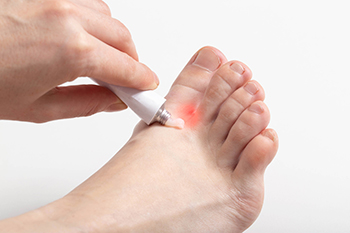Connect With Us
Blog
Effective Prevention Techniques for Athlete’s Foot

Athlete’s foot is a foot condition that can be uncomfortable and unsightly. It is caused by a fungus that lives in warm environments such as public swimming pools, shower room floors, and locker rooms. The symptoms that often accompany this can include itchiness between the toes and on the bottom of the foot, and the skin can be white and soggy. Some people have cracked skin with this ailment, in addition to small blisters. Patients who have a weakened immune system may be prone to getting athlete’s foot, in addition to having poor foot hygiene. Some people have learned to avoid athlete’s foot by wearing appropriate shoes while in public places, and refraining from sharing towels, shoes, and socks. It may help to use foot powder inside the shoes, which may aid in prevention. If you have this foot condition, it is strongly suggested that you are under the care of a podiatrist who can prescribe medication for complete healing.
Athlete’s Foot
Athlete’s foot is often an uncomfortable condition to experience. Thankfully, podiatrists specialize in treating athlete’s foot and offer the best treatment options. If you have any questions about athlete’s foot, consult with Cary Golub, DPM from New York. Our doctor will assess your condition and provide you with quality treatment.
What Is Athlete’s Foot?
Tinea pedis, more commonly known as athlete’s foot, is a non-serious and common fungal infection of the foot. Athlete’s foot is contagious and can be contracted by touching someone who has it or infected surfaces. The most common places contaminated by it are public showers, locker rooms, and swimming pools. Once contracted, it grows on feet that are left inside moist, dark, and warm shoes and socks.
Prevention
The most effective ways to prevent athlete’s foot include:
- Thoroughly washing and drying feet
- Avoid going barefoot in locker rooms and public showers
- Using shower shoes in public showers
- Wearing socks that allow the feet to breathe
- Changing socks and shoes frequently if you sweat a lot
Symptoms
Athlete’s foot initially occurs as a rash between the toes. However, if left undiagnosed, it can spread to the sides and bottom of the feet, toenails, and if touched by hand, the hands themselves. Symptoms include:
- Redness
- Burning
- Itching
- Scaly and peeling skin
Diagnosis and Treatment
Diagnosis is quick and easy. Skin samples will be taken and either viewed under a microscope or sent to a lab for testing. Sometimes, a podiatrist can diagnose it based on simply looking at it. Once confirmed, treatment options include oral and topical antifungal medications.
If you have any questions, please feel free to contact our offices located in Williston Park, and Long Beach, NY . We offer the newest diagnostic and treatment technologies for all your foot care needs.
